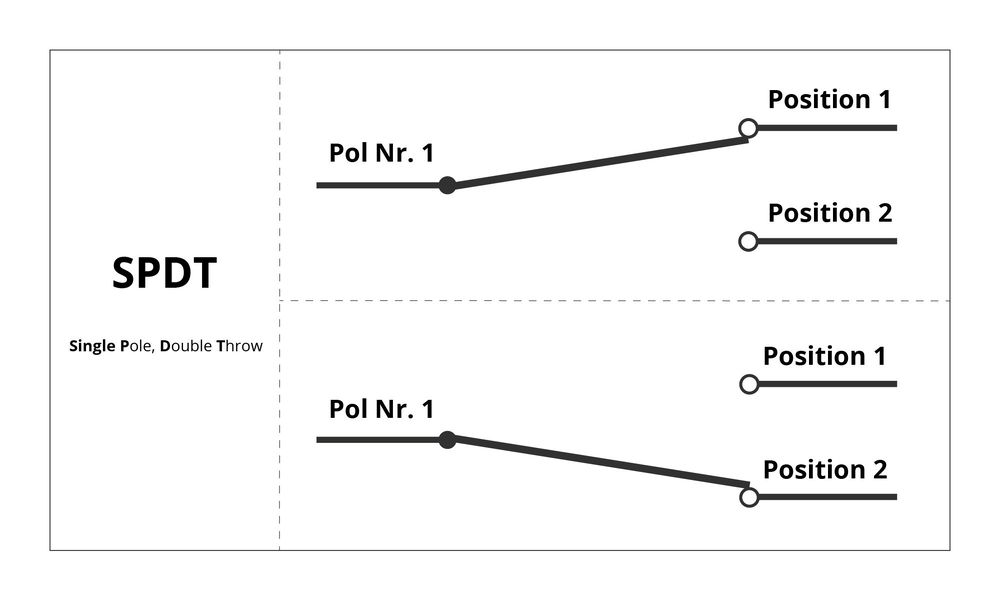9. Switches and Co.
There are dozens of different switches which look almost exactly the same. The sad realization that they aren't all interchangeable usually only comes after purchasing, when you go to install one. In order to help you pick the right one and avoid mistakes in the first place, we have laid out the designations, functions and areas of application of the most important switches below.

Göldo EL012 Mini Switch
Mini-Switches at a Glance
In principle, a distinction is made between on/off and reversing or changeover switches. Schematically, their respective switching functions are as follows:
On/Off Switch:

Simple on/off switches only interrupt the contact between two poles. (geschlossen = closed, offen = open)
Changeover Switches:

1-pole switcher (SPDT)

2-pole switcher (DPDT)
Changeover switches connect the middle pin to one of the two exteriors.
In our guide we have often used the shorthand SPDT and DPDT to describe mini-switches. In this case SP stands for single pole, DP stands for double pole and DT for double throw.
In reality simple on/off switches are rarely used. Most guitars use 1-pole switches, in which the middle pole remains free, to achieve this function.
2-pole switches combine, in principle, two 1-pole switches in parallel which gives a total of six connection poles. These are arranged in two rows 3 to 3.
To better understand how the various switches work we have shown the most common switch types in four sketches below:
Switches

1-pole switch(ON/ON)
1-pole SPDT ON/ON switches are often used for coil splits or as on/off switches (kill switch).
Application of 1-pole ON/ON switches:
- Humbucker/Coil-Tap
- Coil-Tap
- Pickup ON/OFF (Kill Switch)

1-pole switch (ON/OFF/ON)
Application of 1-pole ON/OFF/ON switches:
- Humbucker/OFF/Coil-Tap
- Piezo/Mag+Piezo/Magnetic
- MIDI/MIDI+MAG/Magnetic

2-pole switch ( ON/ON)
Application of 2-pole ON/ON switches:
- Humbucker/Coil-Tap
- In Phase/Reverse Phase
- Active/Passive

2-pole switch (ON/OFF/ON)
Application of 2-pole ON/OFF/ON switches:
- Humbucker/OFF/Coil-Tap
- In Phase/OFF/Out of Phase
- Seriell/OFF/Parallel

2-pole switches (ON/ON/ON)
Application of 2-pole ON/ON/ON switches:
- Neck/Neck + Bridge/Bridge
- Humbucker/Coil-Tap/Parallel
- Humbucker/Coil-Tap/Out of Phase
- Seriell/Coil-Tap/Parallel
The many different configurations of 2-pole switches is often used to combine multiple functions like coil splitting and out-of-phase switching. In the On/On/On configuration the popular serial/split/parallel wiring can be implemented.
Push/Pull and Push/Push Potis

Harley Benton Parts Push-Pull A250
Potis with a built in On/Off/On switch are named after the way you use them, that is push/pull and push/push.
For push-pots, the toggle function is activated by pulling out or pushing in along the pot axis. In the push/push variant, the additional function is switched to the poti axis by pressing lightly. Pushing once for 'on' and again for 'off'.
Which switch you choose is a matter of taste. However, in the heat of the moment, "On Stage", the push/push poti is a favorite as it places the lowest demand on fine motor skills.
DPDT push/pull pots are not available in On/On/On configuration.
Pickup Selector
Traditionally pickup selectors have been used to connect multiple pickups together. One of the most well known is the 3-way toggle-switch, found in classics like Les Pauls or SG's.
The switch has four connection ports and is the ideal thing for managing two humbuckers. Two of the poles of the switch are combined to form the output, the other two are used to connect the pickups (see also circuit diagrams).
The second most common version was originally produced by Fender, it comes in a 3-way and 5-way version and is ideal for guitars with 3 pickups

Fender 5-way Super Switch
The design of these switches is much more complex than that of a 3-way toggle switch and works on two levels. With a typical 5-way Fender pickup selector switch, for example, the following pickup combinations are possible:

Possible circuits with a 5-way fender pickup selector.
The underlying wiring of these set-ups can be found in the section "Circuit Diagrams".
Modern guitars are often equipped with a humbucker in the bridge and neck position and a single coil in the middle. With a 5-way lever switch, the following connections can be made:

Possible circuits with a 5-way lever switch.
The underlying wiring of these set-ups can also be found in the section "Circuit Diagrams".
With the support of a modern 5-way/4-pole switch there are many different ways to manage your pickups. Especially when you choose the flexible HSH equipment, a typical H/S/H circuit with 4-wire humbuckers allows for the following set-ups:

H/S/H Circuits with 4-wire humbuckers.
So, you electronic hobbyist, that's about it. We hope that our guide on the subject of pickup installation has helped you a bit and that you'll be able to get started on you own guitar. Have fun soldering!
















